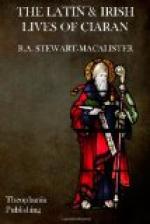For now liveth he in rest without labour, in age without senility, in health without sorrow, in joy without grief, in peace without a foe, in wealth without poverty, in endless day without night, in the eternal kingdom without end, before the throne of Christ, Who with the Father and the Holy Spirit liveth and reigneth unto ages of ages. Amen.
Here endeth the life of Saint Ciaran, Abbot of Cluain meic Nois.
[Footnote 1: The inconsistencies in the spelling of the various proper names in this translation follow those in the original documents.]
[Footnote 2: The MS. reads lac iam... effudit. For iam we should probably read enim. A similar correction is made in Sec. 38.]
[Footnote 3: Ipsa insula semper ab Hybernia habitatur. The sense of this passage is not clear: it may be corrupt.]
[Footnote 4: Lit.: “the shadow of the aid of thy dutifulness.”]
[Footnote 5: This sentence reads very awkwardly, owing to the incorporation of two originally interlined glosses. Reference to the MS. enables us to isolate these. The sentence there runs thus: “Si ergo in isto loco mansissem non Ysseal .i. imus esset id est non paruus sed altus .i. magnus et honorabilis.” Here id est occurs three times, once in full, and twice represented by the common contraction .i., which is universally used in MSS. of Irish origin for the introduction of a gloss. If we write the sentence as below, we shall see the significance of the different ways in which the expression is written, and by expunging the glosses can make the sentence less clumsy and more intelligible
_.i. imus_ —“Si ... mansissem, non Ysseal esset, id est non paruus; sed _.i. magnus et honorabilis_ altus.”]
[Footnote 6: Correcting the vita of the MS. to via, in conformity with VG.]
* * * * *
THE SECOND LATIN LIFE OF SAINT CIARAN
II. THE ORIGIN AND BIRTH OF CIARAN
1. A glorious man; and an abbot in life most holy, Queranus, was born of a father Boecius, of a mother Darercha. This man drew his origin from the northern part of Ireland, that is, he was of the Aradenses by race. Now he was so illuminated by divine grace from his boyhood, that it was clearly apparent of what manner he was destined to be. For he was as a burning lamp in extraordinary charity, so as to show not only the warmth of a pious heart and devotion in relieving the necessity of men, but also an unwearied sympathy for the needs of irrational animals. And because such a lamp should not be hidden under a bushel, so from his boyhood he began to sparkle with the marvels of miracles.
III. HOW CIARAN RAISED THE STEED OF OENGUS FROM DEATH
2. For when the horse of the son of the king of that territory perished with a sudden death, and the young man was much grieved at its fall, there appeared to him in dreams a man of venerable and shining countenance, who forbade him to be grieved for the death of the horse, saying unto him, “Call,” said he, “the holy boy Keranus, and let him pour water into the mouth of thy horse, and sprinkle its forehead, and it shall revive. And thou shalt endow him with due reward for its resurrection.”




